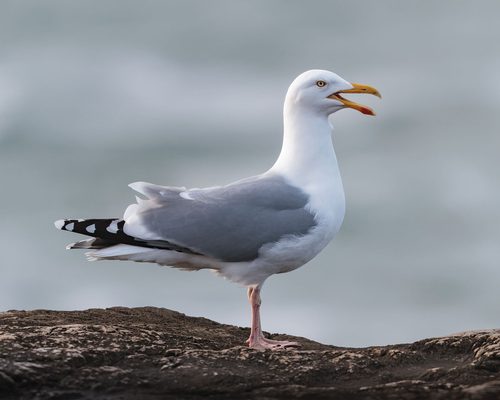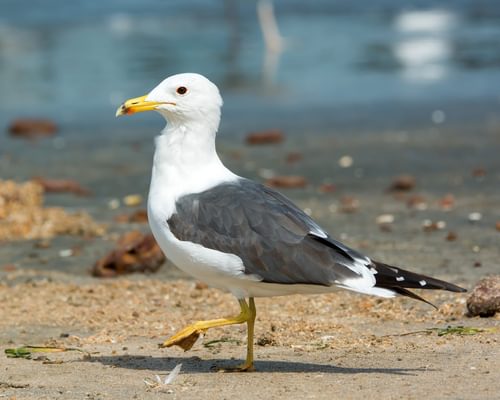Great Black-backed Gull
Least ConcernLarus marinus
Visual Identification
Appearance
The Great Black-backed Gull is the largest gull species. Its distinctive black back and wings contrast sharply with its white head, neck, and underparts. Its powerful yellow bill has a red spot on the lower mandible, and its legs are pink.
Adults maintain this plumage year-round, while juveniles are mottled brown and gradually acquire adult plumage over four years. There is no significant difference between male and female appearance.
Apart from their larger size, these gulls appear similar to other Larus species like the Herring Gull (gray back) and Lesser Black-backed Gull (yellow legs).
Size
Length
64cm to 79cm
Wingspan
150cm to 170cm
Weight
1.05kg to 2.5kg
Colours
Males and females have similar plumage
Primary Colour
White Black
Secondary Colour
Grey
Beak Colour
Yellow
Leg Colour
Pink
Habitat and Distribution
Habitats
Woodland
Garden
Wetland
Coastal
Urban
Farmland
Grassland
Desert
Tundra
Rainforest
Mountain
Savanna
Distribution
Great Black-backed Gulls primarily inhabit coastal areas, including rocky shores, estuaries, and harbors. They are found along North America's and Europe's Atlantic coasts, from the Arctic to the Mediterranean.
In North America, they are common along the eastern seaboard, while in Europe, they are widespread in the UK, Ireland, and Scandinavia. Some populations move inland during winter, frequenting large lakes and reservoirs.
Elevation Range
Sea level to 100 meters
Climate zones
Temperate, Subarctic
Distribution Map
This map gives you a rough idea of where you might spot a Great Black-backed Gull. The coloured areas show countries where these birds have been seen.
A few things to keep in mind:
- Birds might not be everywhere in the coloured areas, for example, they may be present around the coast of that country
- Where birds live can change with seasons and available food
- This map is quite simple - it doesn't show exact locations
We're working on making our maps even better! Soon, we hope to show you:
- More detailed maps for bigger countries, including state and region
- How birds move around during different seasons
Distribution by Region
Behaviour and Ecology
Bird Attributes
This feature is in beta. We'd love your feedback to improve it!
Share your thoughtsBird Attributes Explained
Our bird attributes system rates various aspects of a bird's capabilities on a scale of 0-100, based on data from field observations, scientific studies, and expert knowledge.
Attribute Categories:
- Agility: Manoeuvrability, speed, and grace in flight or movement.
- Strength: Physical power, often correlating with size and hunting abilities.
- Adaptability: Ability to thrive in various environments or changing conditions.
- Aggressiveness: Territorial behaviour and assertiveness, particularly during breeding seasons.
- Endurance: Stamina, often seen in migration patterns or foraging behaviours.
Understanding the Ratings:
- 0-20: Very Low
- 21-40: Low
- 41-60: Average
- 61-80: High
- 81-100: Very High
Remember, these attributes are relative to other bird species and don't necessarily indicate superiority.
Hover over the icon next to each attribute for more information.
Tap the icon next to each attribute for more information.
Agility
Reflects the bird's manoeuvrability, speed, and grace in flight or movement.
The Great Black-backed Gull demonstrates considerable agility in flight and when hunting. Its ability to manoeuvre effectively to steal food from other birds and drop hard-shelled prey from heights indicates good aerial dexterity.
Strength
Indicates the bird's physical power, often correlating with size and hunting abilities.
As the largest gull species, the Great Black-backed Gull possesses remarkable strength. Its powerful bill allows it to prey on larger animals, including adult puffins and rabbits, showcasing its physical prowess.
Adaptability
Represents the bird's ability to thrive in various environments or changing conditions.
This species exhibits high adaptability, thriving in various coastal environments and even moving inland during winter. Its opportunistic feeding behaviour and diverse diet, including scavenging at landfills, further demonstrate its adaptable nature.
Aggressiveness
Measures the bird's territorial behaviour and assertiveness, particularly during breeding seasons.
Great Black-backed Gulls are known for their aggressive behaviour, particularly in food acquisition. They frequently steal food from other birds and are territorial during breeding season, indicating a high level of aggression compared to many other bird species.
Endurance
Reflects the bird's stamina, often seen in migration patterns or foraging behaviours.
While specific endurance data is limited, the Great Black-backed Gull's ability to patrol coastlines for food, engage in long-distance seasonal movements, and its long lifespan of over 25 years in the wild suggest good endurance. However, it's not known for extreme long-distance migrations like some other seabirds.
Diet
Great Black-backed Gulls have a varied diet, including fish, mollusks, crustaceans, and smaller birds. They are also known to scavenge on carrion and scraps, often seen at landfills or following fishing boats.
Their powerful bill allows them to prey on larger animals, including adult puffins and rabbits. They find their food in the intertidal zone, at the surface of open water, and around seabird colonies.
Behaviour
Great Black-backed Gulls are opportunistic feeders, often seen patrolling coastlines for food. They are known for their aggressive behavior, frequently stealing food from other birds.
These gulls are less gregarious than other gull species, often seen alone or in small groups rather than large flocks.
Vocalisation
The Great Black-backed Gull has a deep, resonant call, often described as a loud "kyow" or "laughing" sound.
During the breeding season, they produce a variety of vocalizations, including a series of low "ha-ha-ha" notes when defending territory or interacting with mates.
Nesting & Breeding
Breeding occurs from late April to August, with pairs often returning each year to the same nesting site. Great Black-backed Gulls typically nest on coastal cliffs, islands, or sometimes flat ground near water.
The nest is a large mound of vegetation, feathers, and debris. Females lay 2-3 eggs, which are olive-brown with dark blotches. Both parents share incubation duties.
Incubation lasts about 27-28 days, and chicks fledge after 6-7 weeks. Young gulls reach sexual maturity at 4-5 years of age.
Lifespan
years
The Great Black-backed Gull typically lives for 20 to 27 years.
Like all birds, lifespan can be affected by factors including predation, habitat quality, disease, and access to food sources.
Conservation and Status
Global Conservation Status
While currently listed as Least Concern, Great Black-backed Gulls face threats from habitat loss, pollution, and climate change. Some populations have declined due to reduced food availability and human disturbance at nesting sites. Conservation efforts focus on protecting breeding colonies and managing coastal habitats.
Population Data
Global Population Estimate
690,000 - 940,000 mature individuals [2]
Global Population Trend
Trend data may be uncertain or fluctuating
Birdwatching Tips
- Look for the largest gull on the beach or at sea
- Observe its distinctive black back and wings against its white body
- Watch for aggressive behavior towards other birds
- In the UK and eastern North America, check coastal areas and large inland water bodies
Additional Information
Quick Facts
Other names:
Greater Black-backed Gull
Family:
LaridaePredators
Adult Great Black-backed Gulls have few natural predators, but eggs and chicks may fall prey to foxes, rats, and other large gulls.
Did You Know?
- Great Black-backed Gulls can live for over 25 years in the wild.
- They are known to drop hard-shelled prey from heights to break them open.
- These gulls are capable of swallowing a puffin whole.
Was this bird profile helpful?
Your feedback helps us improve our content
Thanks for your feedback!
Your input helps us improve our content.
Community Experience
Community Ratings
No ratings yet - be the first to rate this bird!
Latest Community Reviews
No reviews yet
Sign in to be the first to review
Community Reviews
Create Your Free Account Welcome Back!
Join our community to rate birds and share your experiences. Creating an account is completely free and only takes a minute. Sign in to your account to rate birds and share your experiences with our community.
Your information is secure and will never be shared.
By creating an account, you agree to our Privacy Policy.
Similar Birds
References
- 1
website: BirdLife International. 2018. Larus marinus. The IUCN Red List of Threatened Species 2018: e.T22694324A132342572.
View source - 2
report, 2015: Wetlands International

